
The first three steps of the Genealogy Brick Wall Busting Process are:
- Step 1: Which is to Review Previous Research on Your Brick Wall Ancestor.
- Step 2: Which is to take everything from Step 1 and rearrange it into a timeline.
- Step 3: Which is to analyze everything as a whole that you looked at in detail in steps 1 & 2.
Now we are ready to begin Step 4: Make a Research Plan. Steps 1-3 have really created a great foundation for Step 4 and will help us work through this step quickly.
Watch This Episode, or Continue Reading Below
This post is part four of a multi-part series on how to bust through genealogy brick walls and discover the identity and life story of even your toughest, elusive ancestor. Here are the previous installments:
- Part 1 – Review Previous Research
- Part 1 – Case Study
- Part 2 – Make a Timeline
- Part 2 – Case Study
- Part 3 – Analyze Everything
- Part 3 – Case Study
Start Your Research Plan
NOW we come back to the part that most genealogists like to jump right into from the beginning… the research! But, hold up just a minute. We are back to the research, but we are going to do it in an orderly way: by making and then following a RESEARCH PLAN.
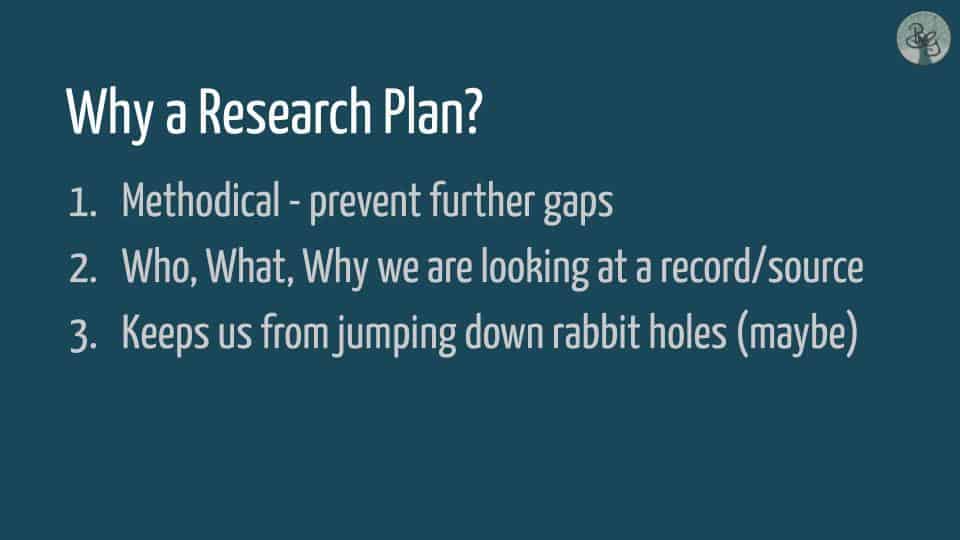
A research plan will help us in several ways. First, a plan will help us be methodical in our search. It will help us to fill in the timeline gaps and resolve the discrepancies that we found in the first three steps of our project.
Next, a plan will help us to clarify who we are looking for in the record or source, what we expect to find in that source, and why that source is the one that we want to look at for this particular question.
Third, a research plan will (hopefully!) keep us from jumping down those pesky genealogy rabbit holes. You know, the one where something interesting from a document we just found leads us on a wild chase for another record or on to another ancestor and we forget what we were really searching for in the first place.
Instead of immediately acting on those interesting tidbits, we can add another item to our research plan and get to it in an orderly way.
How to Format Your Plan
Start a new document for the research plan. You can create the plan in a spreadsheet format, or a word processing document with a table.
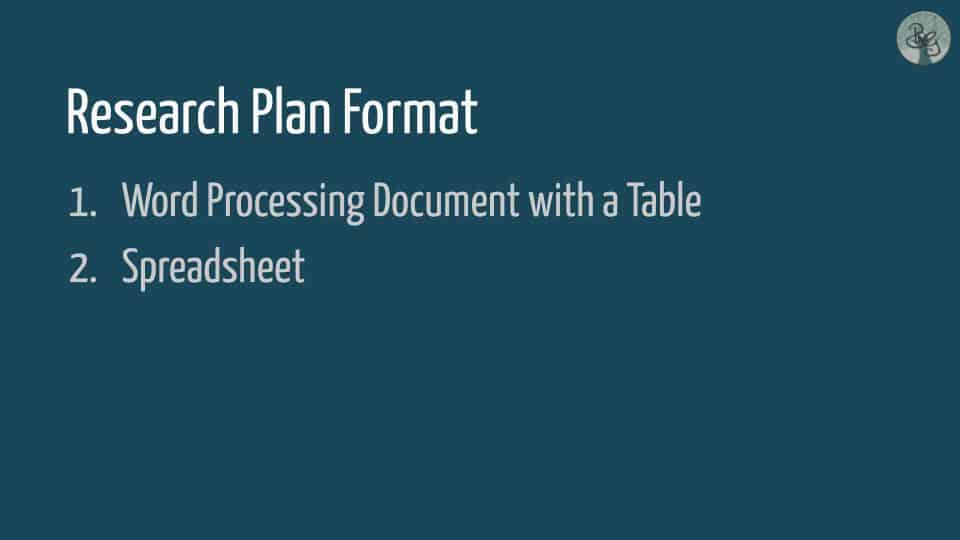
The spreadsheet format will be useful if you like to keep track of your research in a spreadsheet format. This format will also work well for you if you use spreadsheets regularly to sort and view information. A spreadsheet research plan lends itself well for use as a research log, if you like to use a research log as you research and write up your conclusions later.
A word processing document with a table format will work well for you if you like to write up your genealogy research as you go. It would also be a good choice if you are more familiar with word documents than spreadsheets.
Organize Your Research Plan
There are several different ways to organize a research plan. Decide on an organization system based on the order in which you like to research, or in a way that makes the most sense for the particular project.
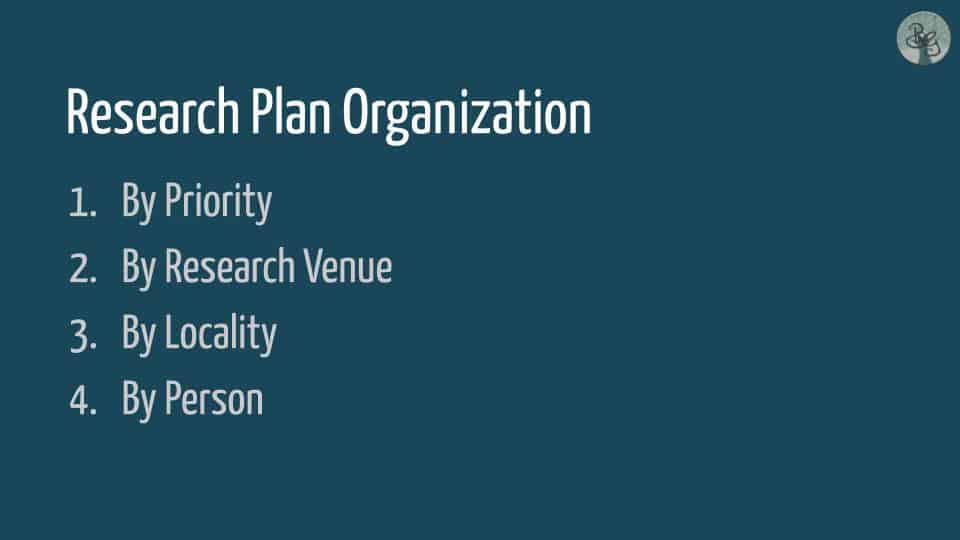
Organize the research plan by priority: This means that the plan will list the most useful, accessible, or pressing source to search first, with less useful or more time-consuming sources at the end of the list.
Organize the research plan by venue: This means the plan will have a section for each venue that you will be performing research at, including online and offline. All the FamilySearch website searches will be grouped together. All the county courthouse in-person searches will be grouped together, etc.
Organize the research plan by locality: This means the plan will be divided by the location where the record was created, or where the ancestor lived when the record was created. So, if your ancestor lived in Maryland and Kentucky, the plan would have a section for each of those places.
Organize the research plan by person: This means the plan will have a section for the brick wall ancestor and the searches that will relate to them. It may have another section for their spouse, and another for the oldest son, etc.
Column Headings for the Plan
Whether you set up the research plan in a spreadsheet or word document table, you will have similar columns for arranging the information in your plan.
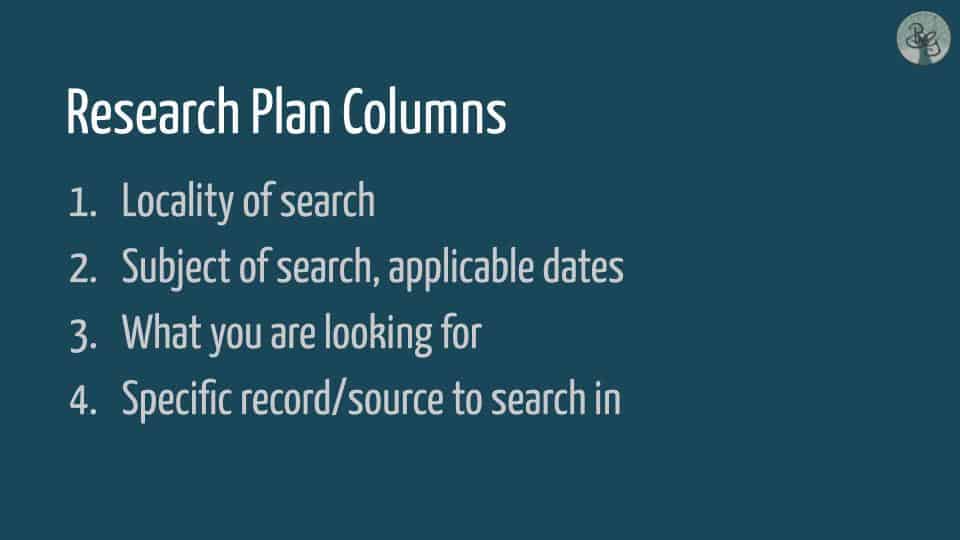
The first column will list the locality, or place, of the search. If your ancestor lived in a particular county or parish, this location will be listed in the locality column.
The next column will note the names and dates of the search. This could include one or more than one name and a range of dates when the person(s) may have been recorded in a particular source.
The third column will clarify what you are looking for in your search, i.e. the birth certificate, baptismal record, or tax listings.
The information for the first three columns should be easy to transfer directly from the notes and analysis made during Steps 1-3 of the Genealogy Brick Wall Busting Process. Each discrepancy, question, gap, or other issue noted in Steps 1-3 will become an individual entry on the research plan.
The final column will list one or more than one specific sources to be searched for this particular entry. This column may take a little work to fill out.
How to List Specific Sources in the Plan

In order to list specific sources on the research plan, you must find out which sources exist that can help answer the question or resolve the problem listed on each entry of the plan. There are several resources that can help you with this task.
FamilySearch Wiki
The FamilySearch Wiki has thousands of articles detailing the best sources and information about a particular location you may be searching in, or specific topics such as religion, occupation, etc.
FamilySearch Catalog
The FamilySearch Catalog details the entire collection and holdings of the Family Search Library in Salt Lake City, Utah, as well as the FamilySearch website. Searching by location or keyword can reveal many sources that may be a great fit for an entry on the research plan.
Ancestry Wiki
The Ancestry Wiki has articles for many localities, explaining the history, the record collections, and the Ancestry records available for that area.
Ancestry Card Catalog
The Ancestry Card Catalog lists the entire collection and holdings of the Ancestry.com website. This includes many databases that are not searched in a general search on Ancestry. Search by the locality in the keyword search to find relevant databases.
Major Repositories for the Locality
Consider collections found either online or onsite from major repositories, libraries, and archives for the area you are researching in. For example, if I were looking for Missouri resources, I would want to include the Missouri State Archives/Missouri Digital Heritage website in my quest for sources to fill in my research plan. This website has many online databases and finding aids for Missouri records not available elsewhere.
Finish the Plan… Then Research
Work through each item on the research plan until you have a specific source listed. Then comes the part every genealogist has been waiting for… the research! Begin at the top of your plan and work your way through.
I’ll meet you here again soon to talk about what we do after we research and complete each action item on our research plan. Until then, good luck with your genealogy brick wall project!
Pin For Later
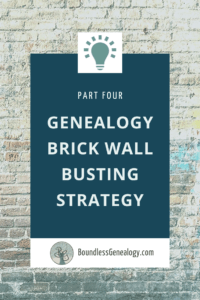

See you next time,
Melissa





